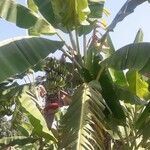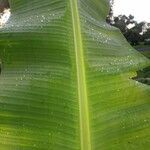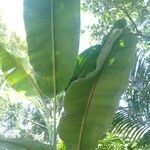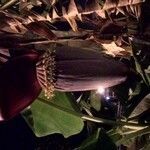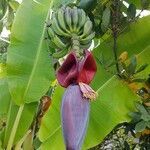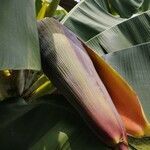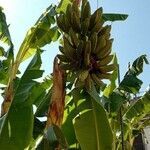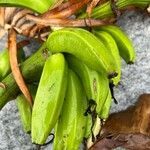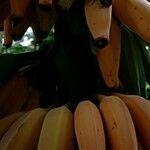Giant herb arising from a short horizontal branching rhizome.. Pseudostems formed from the overlapping leaf-bases, up to 5 m. high, usually less than 25 cm. in diameter.. Leaf-blades oblong-lanceolate, to 2-2.5 × 0.4-0.6 m., apex truncate, base rounded, petiole and midrib green, somewhat glaucous.. Inflorescence appearing from the top of the pseudostem, horizontal or deflexed; peduncle pubescent.. Bracts of the ♂ part of the inflorescence red, quickly deciduous, each subtending ± 20 flowers.. Outer 3-lobed tepal of ♂ flowers 3.5-4.5 cm. long and ± 1.2 cm. wide, yellow above; inner tepal ± 1.5-2 cm. long, the apiculum 1-2 mm. long; stamens 5, 4-5 cm. long.. Bracts of the ♀ part of the inflorescence red, deciduous, each subtending up to 16 flowers.. Outer 3-lobed tepal ± 2.5 cm. long, yellow at the apex; free tepal ± 1.5 cm. long, translucent; ovary glabrous, or partially or entirely pubescent.. Fruits 10-20 in each group, each 8-13 cm. long, 1.5-3 cm. in diameter, first green but becoming yellow when fully ripe.. Seeds irregularly depressed-spherical, 6-7 × 3 mm., dull black.
The banana false stems usually have black marks on them. The canal of the leaf stalk is like an open drain. There are dry flaps where the leaf stalk joins the false stem. The leaves are paddle shaped. These are diploid bananas. They can be seeded or seedless. The flowers hang down. They are pear shaped and yellow, white or cream. The fruit are yellow. This is the small diploid variety. Many bananas are hybrids between acuminata and balbisiana. See Musa x paradisiaca.
Pseudostems heavily blotched with brown or black. Petioles: margins of adaxial groove erect, winged proximally. Inflorescences: pedicels short; bracts of staminate flowers lanceolate or narrowly ovate, apex acute, abaxial surface yellow, red, or dull purple, adaxial surface yellow proximally, often yellow or dull purple distally. Staminate flowers white or cream. Pistillate flowers: stigmas deep yellow or orange; each locule with 2 regular rows of ovules.
Pending.
